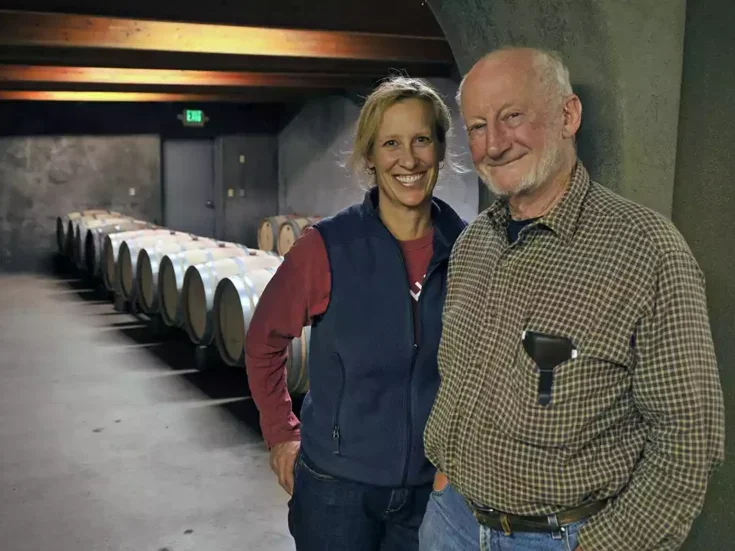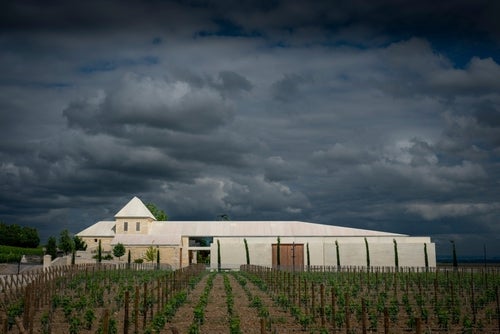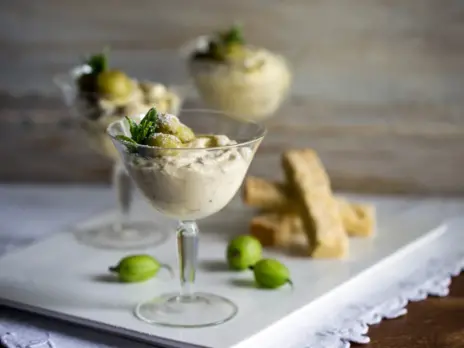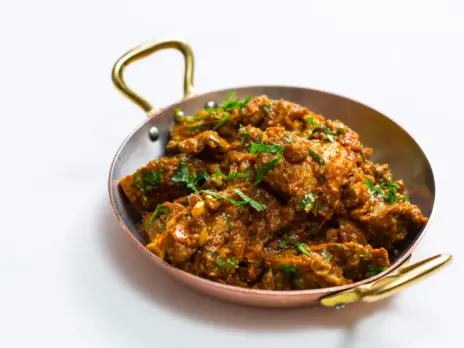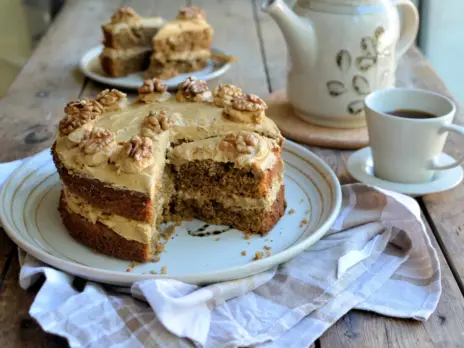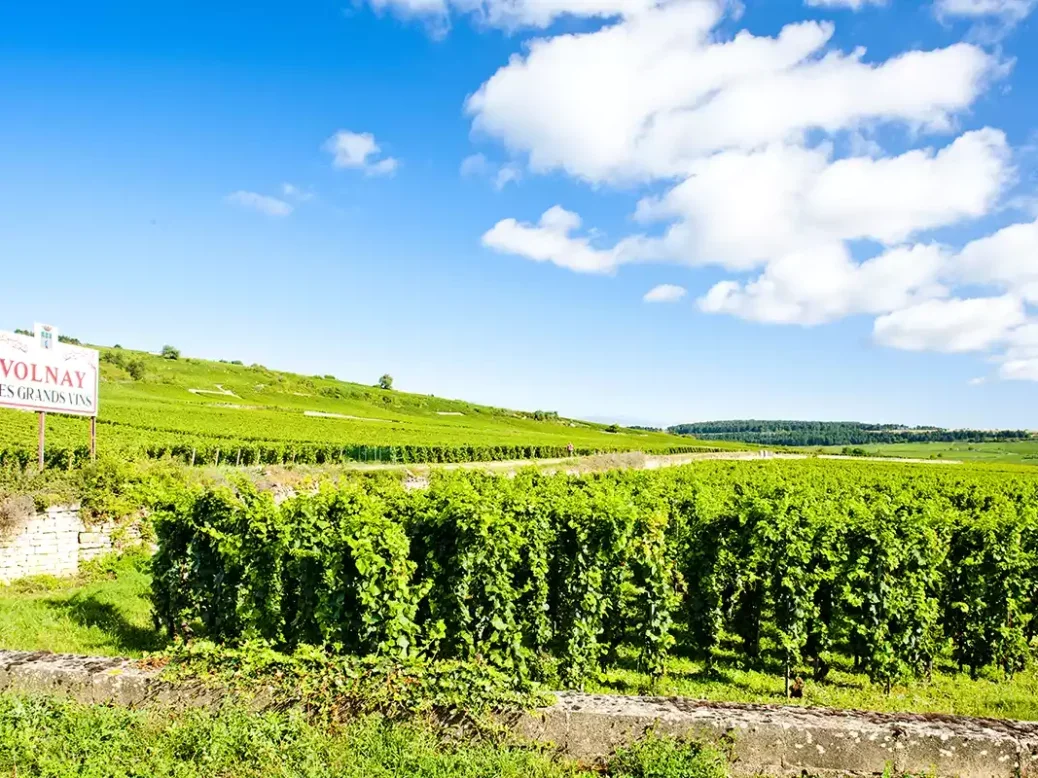
VOLNAY
DOMAINE DU MARQUIS D’ANGERVILLE
François Duvivier told me they did no green-harvest and began picking on September 5 with Fremiets and Mitans, then Cailleret straight after. The average yield was 40hl/ha, following a light sorting of a few dry berries. He made no adjustments. Alcohol levels are quite high—13.5–14%—with pHs levels at 3.5–3.7. As ever, this domaine fully destemmed and used only remontage. It is biodynamic in the vineyard and in the winery, where the fermenting juice is swirled in a figure of eight in a plastic bath-like receptor before returning to pour over the cap. Franois told me, “It is the same as the effect when you make biodynamic practices in the vineyard. It gives the wine more energy, tenacity, and digestibility.” During the active fermentation, this is done twice daily. The vatting lasted 16–18 days, and most of the wines are fermented in wooden vats. There was one rack-and-return to mix the vat at the end. It was not easy to convert all the sugar, and the wines were pressed off to finish in tanks, with anything from two to 14 days before barreling down. “We needed to focus at the end,” says François—no doubt because of the malolactic. The VA levels range from 0.5 to 0.7—“the VA of a warm vintage”—bottling being earlier than normal because of that, and it would also seem sensible when the pH levels are on the high side. Many were to be racked in November and some, including Cailleret, bottled before Christmas 2024. “We don’t see any value in waiting. Such an early bottling of premier cru has never been done here before. We want to capture the fruit expression.”
“It is a seductive, easy, and approachable vintage due to the warm harvest, but we tried to keep the freshness so we could keep the identity of each terroir. Because of the warm weather and the alcohol levels, we didn’t imagine that we would have this freshness. The vintage is maybe quite like 2022, but more tender. The 2023s have always looked good, while the 2022s took more time to evolve. The 2023s will be elegant and easy to drink.”
I usually really enjoy D’Angerville’s elegant style of Volnay, but I am not quite so sure about the 2023s. The wines were probably just going through a phase, and I also wonder whether the sample bottles might not have been opened too many times, as I arrived toward the end of the day, after quite a lot of other visitors. Despite the early picking, the wines are very ripe, into black-fruit spectrum, dark and spicy and a bit heady. There is not a lot of tannin, but the wines are a touch green in places, and not as refined or well-structured as I would expect from this domaine, of which I have high expectations. But in this vintage, there are surprises. I thought that the Taillepieds was very good.
Volnay
Rich, black-cherry fruit. Very ripe but lively enough, with rich, spicy aromatics enveloping the palate. Late-2025–30. 87
Volnay Premier Cru
This includes some fruit from Pitures and Mitans. Exotic spices lead into a juicy, fruity, and quite generous palate. Plentiful fruit, smoothish tannin, and richly aromatic. 2026–30. 88
Volnay Premier Cru Cailleret
This parcel is in the middle of the top section, “where the soil is very white.” Ripe, red-fruit aroma. Juicy, with ripe-strawberry fruit. Modest intensity. A light, soft, gentle, if rather simple, Cailleret. The finish is quite pretty, and here we find a lighter and brighter end to the palate. It was to be bottled before Christmas. 2026–32. 90
Volnay Premier Cru Champans
The domaine is the largest owner of Champans, with 4ha (10 acres), in two strips running from whiter soils at the top, to redder clay and iron soils at the bottom. This is a much fuller and plumper wine. No lack of generosity. Sturdy on the tannins and slighter chewier to finish. I assume they might give this more time before bottling. 2027–32. 92
Volnay Premier Cru Clos des Angles
Fuller, richer, and juicer than the Premier Cru tout court, with deep, dark fruit. Black-cherry ripeness and slightly heady. A dark-fruited and spicy Volnay, with tannins that are thicker, richer, and smoother than the premier cru blend. 2026–30. 90
Volnay Premier Cru Clos des Ducs
This is the most concentrated wine. It is full and rich and sweet in feeling. A soft, rich texture here; more velvety, a waft of exotic aromas enveloping the palate and carrying the finish. 2027–32. 93
Volnay Premier Cru Fremiets
This is very ripe, with dark-cherry aromas and juicy fruit, and an asphalt, grippy character. I like Fremiets, usually, for its strict edge, but it should be tense and vibrant, and this was just a bit grabby and grippy. 2026–30. 89–90
Volnay Premier Cru Taillepieds
There is much more energy and intensity in this Taillepieds. Here there is both black-berry and red-currant fruit. Maybe a mix of ripeness. It is tight and sweet and concentrated, and much more defined at the edges. There are herbal notes, a green snap and crunch. It was probably going to be racked before Christmas and bottled soon after. This seems fresher than the Cailleret, more interesting and with more presence. Certainly my favorite in this line up. 2026–32. 94
DOMAINE HENRI BOILLOT
A rich, opulent, and oaky style at Henri Boillot this year. Alcohol levels are mostly just over 14% for both red and white. Harvest lasted August 29–September 7. Only the village wines had some acid adjustment The Chardonnay was crushed before pressing with a vertical press. Whites are aged in 350-liter barrels with 50% new oak for premiers crus. No bâtonnage and they are not moved for 15 months. The reds are all destemmed, after which the grapes are put in specially designed barrels that have a small glass door through which the grapes are inserted. In the barrels they are kept cold for one week, then the following week they are warmed and are rolled, for two rotations, three times a day during the high-fermentation period. The grapes are removed, pressed, and returned to the same barrels.
The 50% new oak on the premiers crus will certainly take time to digest, so these wines will not come forward as quickly as most this vintage. It will be necessary to wait maybe a year longer than for most. It works well enough with the grands crus. Overly oaky for my palate, but this is the domaine style; they are well-made and show good typicité.
The wines below are a selection from the 20 premiers and grands crus I tasted (in an impressive barrel-cellar in the winery, located on the industrial estate; there’s even a swanky bar area between the two fields of oak.) I preferred the Puligny to the Meursault, where maybe the ripe fruit with the new oak is a little too rich, but I enjoyed the straighter and more refined Genevrières.
Guillaume Boillot describes the whites as “very floral, with great energy and very well-balanced” and compares them with 2020. The reds he compares with 2019, describing them as “very fine and elegant with red fruits, delicate, with fresh cherry pits and silky tannins.”
Meursault Premier Cru Les Genevrières
Straight and intense, with a high mineral line. There is sweet-citrus freshness and good tension on the finish. 2027–33. 93–94
Meursault Premier Cru Les Gouttes d’Or
Full-bodied, with ripe greengage; punchy and succulent, with plentiful new oak and a sweet-citrus note on the finish. 2027–32. 90
Puligny-Montrachet Premier Cru Clos de la Mouchère
This is a 4ha (10-acre) monopole that lies within Perrières. The vines are 75 years old. Barrels are 450 liters and 350 liters. An extra level of fruit intensity compared to the Perrières. Straight, powerful, but more precise at the edges and on the finish, which is longer, the minerality more silvery. 2026–36. 94–95.
Puligny-Montrachet Premier Cru Les Combettes
An opulent and full-bodied wine, rich, with tropical fruit and a thick texture, but not so long on the finish. A bit ponderous. 15% ABV. 2027–32. 91
Puligny-Montrachet Premier Cru Les Perrières
Straight, punchy, quite burly. Nice density. Pushes into an earthy, mineral finish. 2027–35. 93
Puligny-Montrachet Premier Cru Les Pucelles
Silky and creamy; flowery and flowing. It focuses into a fine and delicate, saline-sustained finish. Carries the oak. Lovely example. A pure ribbon of delight. My favorite of the premier cru whites for its refinement. 2027–36. 95
Montrachet Grand Cru
Intense, focused, powerful, and persistent. Certainly rich and ripe. Very consistent across the palate. Powerful length. 2028–40. 97
Red
Volnay Premier Cru Chevret
Attractive, blue-fruit and floral notes on the aroma, with soft and floating tannins on the palate. This is very ripe yet delicate, with a nice line of acidity and crispness, and on the finish, a light, minty note. Not especially long, but I like this pretty and floral Volnay. 2027–34. 92
Chambertin Grand Cru
Red-currant and spicy fruit upfront. It is silky and fluid on the palate, finely textured, and ripples through the long and elegant finish. Rich but bright and focused. There is a lot of oak, but it streams with the fruity intensity on the finish, which is excellent. 2028–40+. 97
Chambertin Clos de Bèze Grand Cru
Opulent, richly fruity, and scented. Expressive and with immediate impact. Extravagant and exotic. Big volume here and, on the finish, a blast of purple aromas. I prefer the quieter and much more restrained Chambertin, but after the “show,” the perfume does linger on the Bèze. 2028–38. 95
Clos de Vougeot Grand Cru
Full and broad and succulent. It has shoulders… which are cloaked with an abundance of oak. It’s powerful, muscular, and punches into a burly finish. Good persistence. 2028–40. 95–96
DOMAINE MICHEL LAFARGE
Frédéric Lafarge comments on the season: “Not very hot, with good light and rain when necessary. We did a very strict debudding. We had a very good flowering, and, in the end, we had normal quantities.” Yields were 38–42hl/ha for red premiers crus and 48hl/ha for regional wines. “We were lucky that the hail hit only the Aligoté. No need for a green-harvest. Harvest started on September 7, with good phenolic maturity, sugar, and acidity.” Whites are about 13% ABV.
For the whites, pressing lasted three to four hours up to 1.5 bar. “It is easy, as we have only 20% of white, we do just one press a day, and a long press is good for the dimension of the wines.” The following summer, the whites were racked and put back into barrel. All the whites are having a second winter in barrel. No new oak on the Meursault and only 10% on the Beaune.
“I think 2022 is a great vintage for aging, but 2023 is more accessible and so we can drink it earlier,” says Frédéric, “but you can also keep 2023, for it is fabulous.”
Bourgogne Aligoté Raisins d’Orés
Hail hit this parcel. Picked on September 22. Ripe, golden fruit, juicy and spicy. Very nice depth and richness, with a slightly savory nuttiness to the finish. 2026–30. 84
Meursault
From Les Vignes Blanches, on the Volnay side of the village below Santenots, and Gargouillot. Both sections have rich clay soils, giving this Meursault its full-bodied, richer feel. Nutty marzipan notes on this rich Meursault. Rounded and savory. 2026–32. 87
Beaune Premier Cru Clos des Aigrots
From 0.25ha (acre) of 40-year-old Chardonnay vines in the top section of the Lafarge holding here, which has white soil with lots of little stones. Harvested September 8. Elderflower aroma. A light, straight, and pure palate. Smooth stone. Lemon pith on the finish. Savory freshness makes the balance with the ripe fruit. Quite delicate. 2026–32. 89
Red
Bourgogne Passetoutgrains L’Exceptional
From 95-year-old vines. Just one cuvée this year because hail hit this spot and they lost some crop in this parcel, which has gravelly soil below the village, with no limestone or clay. Gamay and Pinot are co-planted in the vineyard so are also fermented together, “Better for the final wine they are blended in the vat,” says Frédéric. Blueberry fruit aroma. Juicy red fruit on the palate, with soft tannins. Slightly sappy, which brings some freshness. Fragrant. Pretty. 2026–28. 84
Bourgogne Pinot Noir
From just under Lurets at the bottom of the Volnay slope: “Always elegant and floral, with silky tannins,” says Frédéric. And yes, this is a delightful Bourgogne. Red-cherry fruit, light and pure, with a slight crunch. Engagingly crisp on the finish. Light-footed but with good intensity for a Bourgogne. 2026–30. 85–86
Beaune Premier Cru Clos des Aigrots
The MLF was not finished when I tasted, so there was lots of gas, but this has vivid red fruit, light minerality, and a fine shiver of tannin. Looks promising, for it is not too sweet or ripe, but fresh, pure, and nicely contained. This shows what’s possible in Beaune in this vintage. 2026–32. 92
Beaune Premier Cru Grèves
Mostly from 102-year-old vines but 25% from younger, 7-year-old vines. The MLF was 85% complete (maybe more, I think) when I tasted. Super-juicy, with lucid red fruit and nice acidity. Elegant Beaune. There is a light grip to the tannin, maybe accentuated by the CO2. It is sweet but light-footed, and has both raspberry and minerality to finish. 2026–35. 93
Volnay Vendanges Sélectionnée
From four parcels just below the premiers crus. Intense and floral aroma. Super-silky glide into the palate, which has depth and generosity but also good structure, and on the finish, a firm but fine-textured note of tannin gives freshness. 2026–32. 90
Volnay Premier Cru Caillerets
From 65-year-old vines and some young vines planted in 2020. “We picked this on September 7—it was the second to be picked after Château des Ducs. We had some grapes in 2023 from the new plantings with small and intense grapes, so we vinified the two parcels together.” Some 0.5ha (1.2 acres) is planted in a spiral design, which gives different exposure to the vines. “The vines have a real energy here,” said Frédéric. “They are a massal selection of the domaine, with rootstock 420A, 34EM, and 5C. There is some red soil because of the iron, but also limestone.” It is worked by horse and by hand. The same is true of Clos du Château des Ducs. During the harvest the grapes are carried on a sleigh pulled by horse. A floral, rose-petal aroma. Rich, ripe, summery fruits. This catches the perfect moment of ripeness, for it is super-ripe but not overly sweet, and a salty minerality is left on the palate, which is persistent and focused. A pure and refined Caillerets. 2026–35+. 94–95
Volnay Premier Cru Clos du Château des Ducs
Gorgeous depth of red fruit and so much generosity on both nose and palate; there are floral notes that waft around the palate, and a rich, silky, smooth depth of tannins. It is the most indulgent of these premiers crus, with the most opulent finish. 2027–35. 95
Volnay Premier Cru Clos des Chênes
Another old vineyard (65 years old). Much more reserve, tasted after the Caillerets. The palate is austere and tight. Very intense, channeled, and focused. I like the vigorous and powerful finish. It is ripe, but strict. Excellent terroir expression. My favorite. 2027–35. 96
Volnay Premier Cru Mitans
Blackberry fruit, with an earthy, spicy note beneath. Punchy and gregarious. Fruity. Very yummy and inviting. 2026–35. 93–94
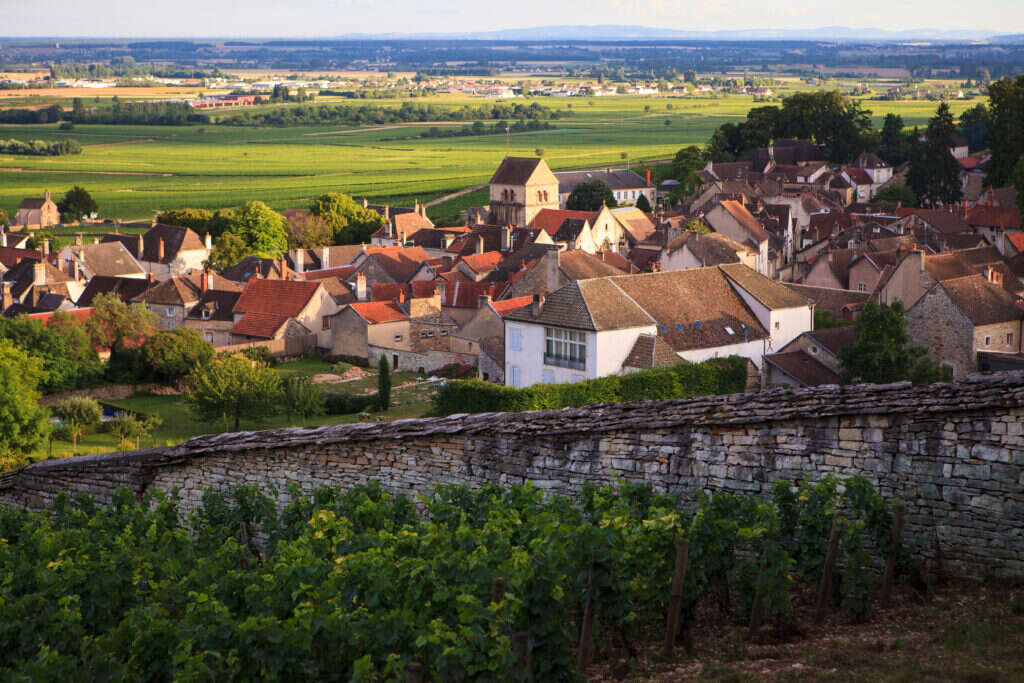
The harvest here lasted August 28 to September 16. “A severe green-harvest was important for the juice-to-skin ratio,” explained winemaker Brian Sieve. “I modified the whole-bunch, as the volume was too high. 2023 had historically high yields for reds at the domaine, though in 2019 it was higher in white.
“A lot of fruit, but when we sorted at harvest, only about 1% was thrown. The stuff was clean. In June, we started dropping fruit, so the bunches would not be touching, and it was all clean. It’s not about the number of bunches, more about the balance for each vine.
“Yields for reds averaged 47hl/ha—52hl/ha was the highest. If it was above 45hl/ha, I did a saignée. A very juicy vintage. I did one more extraction, whereas in 2022 and 2020, if I was at all hesitant, I didn’t. The highest alcohol levels for reds were 13–13.3%. I chaptalized a few at the end, to gain a day in tank. I acidified two. There was more bacteria in 2023, so it was sensible to use some sulfur. I had no stuck ferments. The pH for reds ended about 3.5–3.6; Taillepieds was 3.63 and only one wine reached 3.8. That’s a happy time. There was very little malic—under 2g/l. It’s only 12ºC (54ºF) in the cellar, so the malo doesn’t happen until March.” It is not a vintage to bottle early, as there’s just too much wine. “I will just chip away at it, as I bottle only when the moon is right.
“It is a good vintage, 2023—for the chemistry and the acid profile. I am not too stuffed about alcohol, but it is all on the acidity. For me, the time to pick is when there is one third malic and two thirds tartaric, and this is typically at 13% ABV. You don’t need to be a scientist. Just make sure you take your vacation early enough.
“The reds are bright and fresh and acidic and should age well. I prefer 2023 over 2022, over 2020. I like 2017. If 2023 can be as good as 2017, I will be laughing.”
For the whites, “I take every last bit of lees. If you adapt your press cycle, the lees are always good. And every year the cycle is 10–15% different. It would break the NTU meter—it is over 1000. I press at 0.8–1 bar, and I put that into a tank. I rack the hard press, which goes to 1.5–2. The hard press is not sulfured and this drops out the matter, so I take this away and it’s put in the Bourgogne. I will rack the parts into another tank to stir, so the lees are in suspension before moving to barrel. The whites will tighten, sharpen, and become better with four months in tank.”
The top whites were quite reductive when I tasted. It was a gallop through the whites, as evening was closing in, and most of my notes are too brief to include. Brian considers, “It is like 2019 for the whites, but it is changing—they are more like 2019s now, but in barrels they were showing more like the 2017s. 2023 is better for both reds and whites than I thought at the beginning with all the volume. It’s a good thing that this vintage is an early drinker.”
White
Beaune Premier Cru Les Aigrots
This parcel is below Clos des Aigrots and is quite flat, with quite deep clay over limestone. It is the first vineyard they pick. Full and generous style on the mid-palate, with a firm and sapid finish. It’s well-balanced, with sufficient freshness. Fermented in 500-liter and 600-liter barrels. “It will tighten more,” said Brian. 2026–32. 92
Puligny-Montrachet
Ripe and rich, with some greengage characters. A luscious Puligny, with a light phenolic and saline note to finish. 2026–32. 88–89
Puligny-Montrachet Premier Cru Caillerets
Savory, compact, and dense, and it powers into a long and sturdy finish. Certainly lots of grunt. It’s holding its ground and is not richly fruity. Looks very promising. “Just needs some polishing,” remarked Brian. 2027–35. 95
Red
Bourgogne
From two vineyards below Puligny, one of which is about 75 years old; Brian makes a small cuvée from that part with 100% whole-bunch and later blends it with the other lot. Overall, one third whole-bunch and no new oak. It’s juicy and ripe, with an easy generosity and soft tannins, with just a little lift to finish. Another nice Bourgogne. 2025–39. 85
Nuits-St-Georges Premier Cru Aux Torey
From high on the hillside, facing east, with good drainage on the sandy, limestone soils. 40% whole-bunch. It is quite light, elegant, and pure, but also ripe and smooth, and glides easily over the palate. 2027–35. 93
Vosne-Romanée Premier Cru Aux Malconsorts
Two thirds whole-bunch. 40% new oak. Super-juicy to start, then hunkered down and punchy. It is quite reserved at the moment, but I like the richness and the drive on the finish. 2027–38. 94–95
Vosne-Romanée Premier Cru Aux Malconsorts Cuvée Christian
A cuvée from the northeast corner. More than two thirds whole-bunch and 40% new oak. This is a level up, super-intense and dense. Rich depth of tannins and dark, inky, rich fruit. A full-bodied wine, with a very long and spicy finish, and the whole-bunch brings freshness to the end. Showing very well when I tasted (but apparently less so the previous week, when the main cuvée shone. 2027–40. 95–96
Monthelie Nature
From a very sandy, limestone, village vineyard above Les Duresses under the wood, and another on the other side of this valley on the road to Nantoux. Destemmed fruit. “A little punch down, seven or eight.” The MLF is always early for this wine, as there’s no added sulfur. Bottled before the 2024 vintage. Red fruit. Bright and light, slightly salty and sappy, with a light crunch of tannin. What’s not to like? 2025–29. 86
Beaune Premier Cru Sizies
This climat has clay over limestone. Picked on September 10. 12.95% ABV, pH 3.3. Supple and silky, with fine-textured tannins and a fresh, light finish. A pretty and floating Beaune. Exactly what I want from Beaune. 2026–32. 92–93
Pommard Premier Cru Pézerolles
From sandy limestone. At least one third whole-bunch. 25% new oak. Smooth and silky and pure. Dark fruit, with violet and other floral notes, then on the finish it is sapid and salty to finish. Very good terroir expression, and one of my favorite wines from this side of Pommard in 2023. An elegant sweep. 2027–36. 94
Pommard Premier Cru Rugiens
All from Rugiens-Bas; two parcels by the Hospices and another 200m (650ft) to the north. There is more iron in the soil here and it shows. 80% whole-bunch. 35% new oak. Immediately rich and dense. Quite some muscle here, but it is lithe and toned and powers into the persistent, earthy finish. Marked tension. Top-notch. 2027–38. 95–96
Volnay Premier Cru Champans
Brian says their section encompasses three soil types: sandy limestone at the top, marl in the middle, and clay at the bottom. The fruit from this last section was destemmed. 25% new oak. “Champans is one of the more rustic vineyards in Volnay, and I don’t want to accentuate this, so I try to do a very light extraction.” Juicy, ripe, and generous, succulent with summer fruit. Supple and easy. Somewhat chunky and loose. Soft on the finish. It is very accessible and will have wide appeal. 2026–32. 92
Volnay Premier Cru Taillepieds
Two thirds whole-bunch, as there was just not the space for 100%. 13% ABV and one of the higher pHs here, at 3.65, yet this is also among the freshest to taste. 30% new oak. Upright and energetic. Pounces on the palate. Fine-textured and taut expression. Plenty of energy into the sappy finish. 2027–36. 95
DOMAINE POUSSE D’OR
At Pousse d’Or they describe 2023 as “a vintage of exuberance.” Whites were harvested on September 7, reds from the 14th—they started in the Côte de Nuits, which is unusual—finishing on the 21st in Santenay.
They had an “exceptionally large” crop. They did no green-harvest and there was some concern about ripening the crop because of the cool weather in August, then maturity blocked in early September with the heat. “We had too many grapes. We know that. We threw away a lot. There was some botrytis. We kept only the best.”
The white grapes are sorted by hand and pressed in a pneumatic press, before two days of débourbage, to obtain clear juice. Fermented in 350-liter barrels for the Puligny and 300-liter barrels for the Chevalier. Three or four bâtonnages only, “as this is already always very rich, so we do not want to accentuate this.” Racked into stainless steel after harvest. to be bottled in January.
For reds, it was difficult to find the space, as they have tanks adapted to the size of the vineyards. Ultimately, after the positive sorting, there were yields of 40–45hl/ha for reds. Alcohol levels were around 13%. So, there was a little chaptalization on a few cuvées. All is destemmed, as they use an optical sorting machine. In 2023 there was a cold maceration of five to seven days. Remontage and pigeage for extraction. Normal vatting length. Reds have been pressed with a vertical press since 2009. “It’s a small press but we have lots of small parcels and we have very fine wine with few lees.”
All the reds I tasted were racked and in tank, so were representative samples. 20% new oak, mainly from François Fréres. When I tasted, 20% was quite assertive, and it will take time to calm down on the aroma. These were going to be bottled in January 2025. Usually they bottle in January and February, but a few are taking longer in 2023, including Clos d’Audignac, which will be bottled later. I didn’t get to taste these.
There are three négociant wines: Gevrey-Chambertin, Echézeaux, and Charmes-Chambertin. The vineyards are owned and managed by the Landanger family, just in a holding company. With three children, this gives options for the next generation to have a separate domaine.
White
Puligny-Montrachet Premier Cru Les Cailleret
“It is always very rich on the mid-palate, and when it all came from barriques, it was too rich after three or four years, so we changed the oak size and decreased the new proportion.” Softly salty up-front, this becomes much richer mid-palate, with ripe apricot fruit. Really grows on the palate, then the finish is rich, full, assertive, and sapid to finish. 2027–38. 95
Chevalier-Montrachet Grand Cru
First vintage 2017. Two barrels of 300 liters and then a little in stainless-steel tank for topping up. Intense citrus aroma. Shivers into the palate and grips. Vibrant and focused. I love the austerity and whip of stony minerality. On the finish, there is ripe citrus, but it combines with salinity. Lively, persistent finish. Tip-top terroir expression. 2028–40. 98
Red
Chambolle-Musigny
From seven parcels in the lower part of the village and a few rows of tiny parcels of Borniques and Chatelots. An attractive, juicy Chambolle, with lush fruit up-front, a generous mid-palate with soft tannins, then ripe, raspberry, fruit sweetness to finish. It’s inviting. 2026–32. 88
Charmes-Chambertin Grand Cru
From Mazoyéres. Vibrant blackcurrant fruit, fresh and zesty. An energetic Charmes, which has fine texture of tannins and an appealing crispness. Quite delicate to finish. Charming for Mazoyères. 2027–35+. 95
Clos de la Roche Grand Cru
A lightly exotic, scented aroma on the front-palate, but under this there is a cool and chalky core. Like the Charmes, there is a delicacy to this grand cru. Subtle. Perfumed on the finish. “Over the years, it has become more delicate.” 2027–35+. 95
Echézeaux Grand Cru
From Les Poulaillères. Smooth glide, easy charm, a rich and sensual texture. Dark fruit, ripe blackcurrant. There is sweetness and a balance of acidity woven through into a nicely persistent finish. Very good typicité. 2027–35. 96
Pommard Premier Cru Jarolières
Juicy, ripe, and splashing. Lots of succulent fruit. Full and generous. More open-knit than Bousse d’Or, with chunkier tannins, but I like the enthusiasm of the wine. An easy harmony and accessibility. This is the wine that most quickly sells out. 2026–32. 92–93
Volnay Premier Cru En Caillerets
Harvested on September 19 and 20. Juicy, dark, black-cherry fruit aroma, with quite structured tannin, richly textured and with just enough balancing acidity. Fresh crunch of red-cherry fruit to finish. 2027–33. 92
Volnay Premier Cru Clos des 60 Ouvrées (Monopole)
Rich, dense, dark, red-cherry fruit. Sweet and ripe attack, but more energy than the previous wine. Smooth, quite light tannins, coming more from the oak. The finish has a cracked cherry-kernel note, which gives it lift and bite. 2026–34. 93
Volnay Premier Cru Clos de la Bousse d’Or (Monopole)
From a 2.14ha (5.2-acre) clos in the middle of Volnay. This is more refined than the Caillerets. Fine-textured, with lighter tannins. Red fruit, good tension, and a light vibration to the finish. Slightly saline at the end. An elegant Volnay. 2026–32. 94
Corton Bressandes Grand Cru
Rich, ripe, summer fruits. Full-bodied and sumptuous. A broad palate. Really rather opulent and the texture is soft. The François Frères oak here brings the tannic freshness and combines with the ripe fruit to stretch out the wine, so that it is both sweetly fruity and sappy to finish. It makes for a well-balanced Corton. 2026–35. 94
2023 Burgundy: Abundant variability
2023 Burgundy: A guide to the villages and vineyards
2023 Burgundy: Chablis with a sunny disposition
2023 Burgundy: Chablis tasting notes
2023 Burgundy tasting notes: Côte de Nuits—Marsannay and Fixin
2023 Burgundy tasting notes: Côte de Nuits—Gevrey-Chambertin
2023 Burgundy tasting notes: Côte de Nuits—Morey-St-Denis
2023 Burgundy tasting notes: Côte de Nuits—Nuits-St-Georges
2023 Burgundy tasting notes: Côte de Beaune—Beaune
2023 Burgundy tasting notes: Côte de Beaune—Pommard


